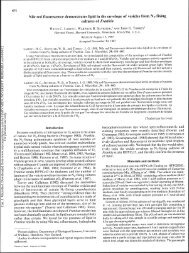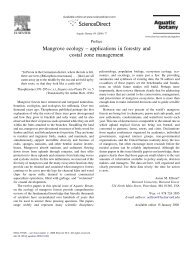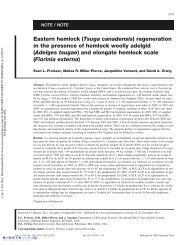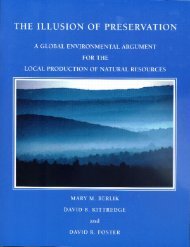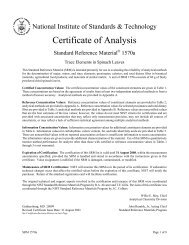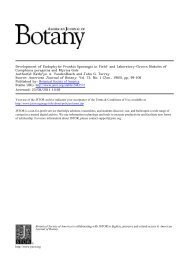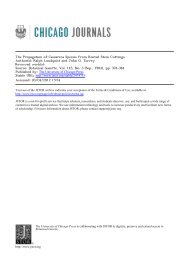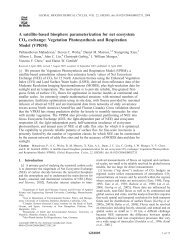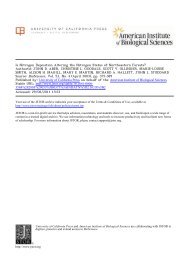Abstracts of Papers - Harvard Forest - Harvard University
Abstracts of Papers - Harvard Forest - Harvard University
Abstracts of Papers - Harvard Forest - Harvard University
You also want an ePaper? Increase the reach of your titles
YUMPU automatically turns print PDFs into web optimized ePapers that Google loves.
ship between auxin concentration and H+ efflux<br />
(Rayle, 1973 - Planta), we postulate a mechanism for<br />
phototropism based on change in relative hormone con-<br />
centrations between opposite sides <strong>of</strong> these struc-<br />
tures.<br />
WEBSTER, HAROLD J. Biology Department,<br />
DuBois Campus, The Pennsylvania State<br />
<strong>University</strong>, DuBois, PA 15801 - Elemental<br />
Analyses <strong>of</strong> Splachnaceae and Their Sub-<br />
strates.<br />
The elemental analyses <strong>of</strong> field-collected<br />
plants and their substrates and <strong>of</strong> labora-<br />
tory-cultured plants <strong>of</strong> the Splachnaceae<br />
provided evidence in reference to the<br />
nitrophile hypothesis. The Splachnaceae<br />
exhibit strong affinities for substrates <strong>of</strong><br />
animal origin, which has been suggested as<br />
a requirement for nitrogen. Owl pellets<br />
and dung with and without plants <strong>of</strong> the<br />
Splachnaceae had relatively high levels <strong>of</strong><br />
N, P, and Ca. Field-collected taxa had<br />
slightly higher elemental percentages than<br />
other cold-region bryophytes. The higher<br />
Ca and P levels reflect substrate contents.<br />
Tetraplodon mnioides plants had higher Ca,<br />
P, and N percentages than did the more<br />
hydric Aplodon wormskjoldii plants. Anal-<br />
ysis <strong>of</strong> cultured plants shows no major dif-<br />
ferences among taxa or among media used,<br />
although deficiency levels were indicated<br />
for plants grown on media with low levels<br />
<strong>of</strong> Ca, N, and Mg. Comparison <strong>of</strong> field and<br />
culture analyses suggests field plants may<br />
be nitrogen deficient despite the high<br />
nitrogen content <strong>of</strong> their substrates.<br />
Symposium: A Developmental and Structural<br />
Perspective on Phenotypic Plasticity: A<br />
Contribution to its Delineation<br />
INTRODUCTION<br />
When the concept <strong>of</strong> phenotypic plasticity is invoked,<br />
it is usually in reference to the impact <strong>of</strong> external<br />
environments on plant form. There are two possible<br />
ways to view phenotypic plasticity. One is that it<br />
represents an additional set <strong>of</strong> developmental events<br />
induced by the external environment and, in that con-<br />
text, represents something added to the normal dev-<br />
elopmental processes in a plant. The other is that<br />
it is a manifestation <strong>of</strong> the normal developmental<br />
events seen in the ontogeny <strong>of</strong> any plant. It is the<br />
purpose <strong>of</strong> this symposim to present information on<br />
plant development, including that <strong>of</strong> phenotypically<br />
plastic systems, to assess which <strong>of</strong> the two views<br />
presented above, or any others, are most appropriate<br />
for understanding phenotypic plasticity. An under-<br />
standing <strong>of</strong> the underlying basis for phenotypic<br />
plasticity is <strong>of</strong> significance in attempting to ex-<br />
plain the evolutionary and developmental consequences<br />
<strong>of</strong> its existence.<br />
Organized by Jack Maze, <strong>University</strong> <strong>of</strong> British Colum-<br />
bia, Vancouver, BC.<br />
Developmental and Structural Section 9<br />
WHITTIER, 1R. O., H. PRINGLE, H. A. MILLER & B. A.<br />
WHITTIER. Department <strong>of</strong> Biological Sciences,<br />
<strong>University</strong> <strong>of</strong> Central Florida, Orlando, FL 32816<br />
- Matrix analysis for Pacific insular bryogeography.<br />
Electronic data files established during production<br />
<strong>of</strong> the Prodromus Florae Muscorum Polynesiae (1978)<br />
and the Prodromus Florae Hepaticarum Polynesiae (in<br />
press) provide a data base containing nomenclatural<br />
and distributional records for 174 genera and 1,760<br />
hepatic species, and 254 genera and 1,627 moss<br />
species, reported on 114 tropical Pacific islands and<br />
as shared with 49 circum-Pacific and other world<br />
areas approximating those <strong>of</strong> Index Muscorum (Wijk et<br />
al ., 1959-1967). Files kept current on key-punched<br />
cards for security may be accessed directly by entry<br />
onto Harris 800 disk files. FORTRAN programs enable<br />
production <strong>of</strong> matrices as large as 200 X 200 geographic<br />
areas. Recoding permits organization into<br />
smaller condensed geographic groups or regions. These<br />
matrices display numbers <strong>of</strong> species reported for an<br />
island or its archipelago on the diagonal, and at<br />
matrix intersections in the upper triangle, numbers<br />
shared by two areas. A lower triangle contains<br />
indices <strong>of</strong> similarity. A taxonomic recoding option<br />
permits similar matrix production for genera.<br />
Subprograms list (1) families (either alphabetically<br />
or phylogenetically) with their genera and species,<br />
or (2) genera and species alone, for any single<br />
island, group, or for all islands and groups, and can<br />
ideritify and enumerate reported endemics and their<br />
percentage <strong>of</strong> the known bry<strong>of</strong>lora. Various cluster<br />
analysis routines carn be applied within the program<br />
system. Program construction design is such that<br />
application requires minimal computer experience, and<br />
permits use <strong>of</strong> other taxonomic and biogeographic data<br />
sets (up to 9,999 taxa and 200 geographic areas).<br />
Conversion to a microcompuiter program system is<br />
planned.<br />
DEVELOPMENTAL AND STRUCTURAL SECTION<br />
FISHER, JACK B. Fairchild Tropical Garden, Miami,<br />
FL 33156. - Branching patterns and simulations <strong>of</strong><br />
trees: deterministic vs. stochastic models.<br />
Published attempts at computer modeling <strong>of</strong> the geom-<br />
try <strong>of</strong> tree crowns and rhizomes are reviewed. Deter-<br />
ministic and stochastic (probabilistic) models are<br />
contrasted, and the problems associated with each<br />
method <strong>of</strong> simulating complex biological patterns are<br />
noted. Small changes in the elemental parameters <strong>of</strong><br />
branching geometry (branch angles, branch unit<br />
length) can have major effects on overall crown shape<br />
after many orders <strong>of</strong> branching. While stochastic<br />
simulations produce "realistic" trees, they may not<br />
be meaningful for ecological or adaptational studies<br />
since they obscure local specific phenotypic<br />
responses to environmental or age-dependent condi-<br />
tions, e.g. sun-shade effects, architectural<br />
reiteration.<br />
KAPLAN, DONALD<br />
R. Department <strong>of</strong> Botany,<br />
<strong>University</strong> <strong>of</strong> California, Berkeley, CA 94720<br />
- Heteroblastic development and phenotypic<br />
plasticity in higher plants.<br />
Any effort to study environmentally induced changes<br />
in plant structure (phenotypic plasticity) must be<br />
done against the background <strong>of</strong> the normal develop-




